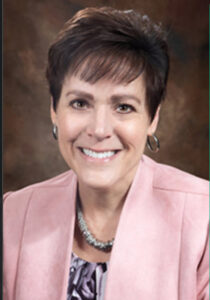Bracety will represent Yavapai County District 5 for the remaining four years of the term of outgoing Board member Mitch Padilla from January 1, 2023, through December 31, 2026
 Yavapai County School Superintendent Tim Carter has announced the appointment of Mr. Stephen L. Bracety to the Yavapai College Governing Board to represent Yavapai County District 5. Mr. Bracety will complete the remaining four years of Mr. Mitch Padilla’s term on the Governing Board. Mr. Padilla resigned after he was elected to serve as Justice of the Peace, Prescott Precinct, beginning in January 2023.
Yavapai County School Superintendent Tim Carter has announced the appointment of Mr. Stephen L. Bracety to the Yavapai College Governing Board to represent Yavapai County District 5. Mr. Bracety will complete the remaining four years of Mr. Mitch Padilla’s term on the Governing Board. Mr. Padilla resigned after he was elected to serve as Justice of the Peace, Prescott Precinct, beginning in January 2023.
Mr. Bracety will be sworn in at a public event at Yavapai College at 9:00 am on Monday, December 5, 2022.
Bracety was selected from three candidates forwarded to Superintendent Carter by a Candidate Review Committee who found all of the applicants qualified for the position. The other two candidates were Mr. Joseph Butner and Mr. Michael Ellegood. The candidate review committee consisted of the following:
Mrs. Mary Mallory, an elected official, who represents this same geographic district as the Chair of the Yavapai County Board of Supervisors. Mr. Chris Tenney, representing the faculty and staff, who is a Yavapai College Professor of Instrumental Music. Mr. Richard Hernandez, representing economic development and business interest, as the Director of the Regional Economic Development Center. Mr. Jacob Todd, representing students, who is studying medical science at Yavapai College. Mr. Matt Zurcher, representing taxpayers, as a realtor, a construction coordinator for Sparklight, and a member of the Central Yavapai Fire Board.
In announcing the selection, Superintendent Carter outlined Mr. Bracety’s background and many accomplishments. He wrote:
Mr. Bracety is well known in the community and has resided here for eighteen (18) years. He has held many positions within the hospitality industry, including service as the General Manager of the Prescott Resort and Conference Center. He is currently the Vice President of Operations and Talent Management with the Grace Hospitality Group.
Mr. Bracety holds a Bachelor of Science Degree from Buffalo State College and a Masters Degree in Business Administration from the University of Phoenix. Mr. Bracety is married, and the couple have a daughter that is a junior at Northern Arizona University.
He has served as the President of the Prescott Frontier Rotary, was named the 2014 Man of the Year by Prescott Area Leadership, has served as the Board Chair of the Prescott Valley Chamber of Commerce. He was formerly on the Board of Directors of the Arizona Hotel and Lodging Association. He has served on the Board of Directors for the Yavapai County Big Brothers and Big Sisters, is the Past President of the Prescott Fine Arts Association, and Past Board Chair of the Arizona Community Foundation. Mr. Bracety was the Founder of the City of Prescott Tourism Advisory Committee.
He has been working with various non-profits for many years on joint educational projects. An example was a recent early childhood literacy initiative, which had tremendous success, under the leadership of the Arizona Community Foundation of Yavapai County, which partnered with community stakeholders for financial support and was operated by the Yavapai County Education Service Agency (YCESA).
District 5 includes the following areas:
Aerie Townhouses Camp Pinerock Glassford Hill
Antelope Meadows Camp Wamatochick Golden Condos
Big Bug Creek Area Castle Canyon Granite Dells
Big Sky Coyote Springs Granville
Bradshaw Pines Camp Creekside of Prescott Groom Creek
Breezy Pine Dana Condominiums Hidden Valley
Camp Maripai Diamond Valley Highlands Center
Jasper Prescott Reamended Preston Condominiums
Kamp Kipa Prescott Valley Pronghorn Ranch
Leigh Condos Prescott Valley Santa Fe Quad Villas
Loba Estates Prescott Valley Superstition Addition Ranch at Prescott
Loma Estates Prescott Valley Unit 1 Roundup Condos
Lynx Creek Prescott Valley Unit 10 SkyYCamp
Lynx Lake Prescott Valley Unit 11 Small Tracts
Lynx Mountain View Prescott Valley Unit 12 Spruce Mountain Club
Millsite Village Prescott Valley Unit 13 Stevens Condominiums
Mingus View Prescott Valley Unit 14 Stoneridge
Mountain Glen Prescott Valley Unit 15 Storm Ranch
Mountain Pine Prescott Valley Unit 16 Tapestry at Granville Apartments
Mountain Shadows Prescott Valley Unit 17 The Ranch
Navajo Commons Prescott Valley Unit 18 The Viewpoint
Noah Berry Prescott Valley Unit 19 Upper Groom
Nugget Patch Prescott Valley Unit 2 Upper Little Copper Creek
Oak Knoll Prescott Valley Unit 20 Victorian Estates
Parbac Condominium Prescott Valley Unit 24 Viewpoint
Patterdell Pines Prescott Valley Unit 3 Walker
Pine Creek Area Prescott Valley Unit 4 Walker Final
Pine Hills Prescott Valley Unit 5 Webfoot Subdivision
Pinehurst Estates Prescott Valley Unit 6 Western Mesa
Poquito Valley Prescott Valley Unit 7 Whispering Pines Camp
Potato Patch Prescott Valley Unit 8 Yavapai Hills
Prescott Commerce Prescott Valley Unit 9 Zone 12
Prescott East Prescott Pines Camp

 Yavapai Community College announced in a November 21 press release that Dr. Barbara Durham was selected as Director of Nursing. Dr. Durham is Prescott based and has been an employee of the Community College since 2017 when she moved from Hartnell community college in Salinas, California where she had taught for 12 years.
Yavapai Community College announced in a November 21 press release that Dr. Barbara Durham was selected as Director of Nursing. Dr. Durham is Prescott based and has been an employee of the Community College since 2017 when she moved from Hartnell community college in Salinas, California where she had taught for 12 years.
 The question of goals the President of Yavapai Community College should achieve came up during a secret executive meeting on November 15, 2022, with the College District Governing Board. Apparently, three goals were agreed upon.
The question of goals the President of Yavapai Community College should achieve came up during a secret executive meeting on November 15, 2022, with the College District Governing Board. Apparently, three goals were agreed upon. 
 On August 9 of this year, Yavapai Community College asked the District Governing Board to convene a special session and devote it exclusively to obtaining Board approval for charging fees amounting to $14,388 per student for the newly resurrected private pilot program. The Board complied and held a one-hour special session.
On August 9 of this year, Yavapai Community College asked the District Governing Board to convene a special session and devote it exclusively to obtaining Board approval for charging fees amounting to $14,388 per student for the newly resurrected private pilot program. The Board complied and held a one-hour special session. Students from Yavapai College’s Master Chorale and Chamber Singers are traveling to New York City in March 2023 to perform Verdi’s “Requiem” at Carnegie Hall. They will be part of a 250 person chorus to perform the “Requiem.”
Students from Yavapai College’s Master Chorale and Chamber Singers are traveling to New York City in March 2023 to perform Verdi’s “Requiem” at Carnegie Hall. They will be part of a 250 person chorus to perform the “Requiem.” Yavapai Community College announced in a press release dated November 9, 2022 that it was recently awarded $1.48 million from the Department of Labor as part of a collaboration with the Arizona Commerce Authority (ACA) and five other Arizona Community Colleges. The College is in the process of evaluating existing programs and services to deliver on the grants focus as well as looking at ways to partner and deliver new programs.
Yavapai Community College announced in a press release dated November 9, 2022 that it was recently awarded $1.48 million from the Department of Labor as part of a collaboration with the Arizona Commerce Authority (ACA) and five other Arizona Community Colleges. The College is in the process of evaluating existing programs and services to deliver on the grants focus as well as looking at ways to partner and deliver new programs. There is an Open Call to the public where a speaker is usually limited to three minutes. Members of the Governing Board are not supposed to discuss or take legal action on matters raised during an Open Call to the public unless the matters are properly noticed for discussion and legal action. on the Board agenda.
There is an Open Call to the public where a speaker is usually limited to three minutes. Members of the Governing Board are not supposed to discuss or take legal action on matters raised during an Open Call to the public unless the matters are properly noticed for discussion and legal action. on the Board agenda.